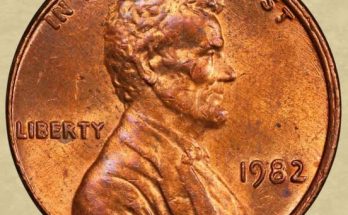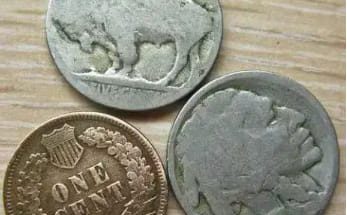In this article, we will be talking about the 1966 dime value, grading, history, and errors. You will find out everything you need to know about this coin so stick around and enjoy!
1966 Dime Value Details
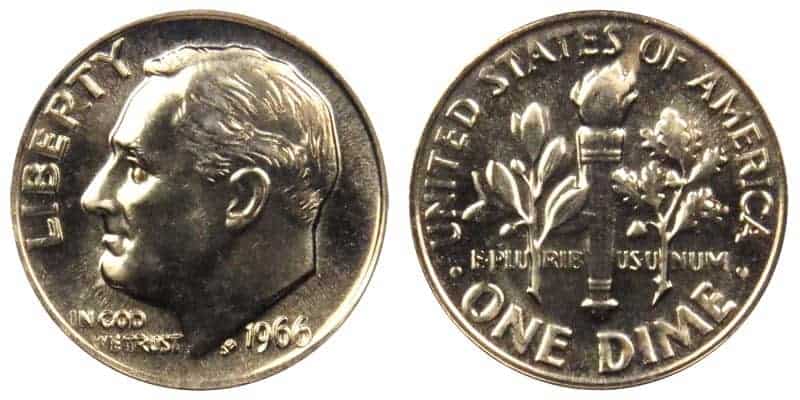
- Category – Roosevelt dimes
- Mint – Philadelphia, Denver, and San Francisco
- Mintage – around 1 400 000 000
- Obverse designer – John Sinnock
- Reverse designer – John Sinnock
- Composition – copper and nickel (91.67% and 8.33%, respectively)
- Weight – 2.26 grams (0.07 ounces)
- Diameter – 17.91 millimeters (0.7 inches)
- Thickness – 1.35 millimeters (0.05 inches)
A dime from 1966 belongs to the category of Roosevelt dimes. It was produced in three mints – Philadelphia, Denver, and San Francisco. What is interesting about this coin is that it doesn’t contain a mint mark, so you can never be sure where your 1966 dime comes from.
The US mint made almost a billion and a half dimes in 1966. The huge number of coins minted makes them quite common on the market, and therefore, not very valuable.
The designer of both the front and the back side of the 1966 dime is John Sinnock, a Chief Engraver of the US mint.
1966 was the first year after the US Mint decided to stop using silver for making dimes due to this precious metal’s increasing prices back then. The 1966 dime is made of copper and nickel, with the latter making up a bit over 8% of each coin.
The 1966 dime weighs 2.26 grams and is almost 18 millimeters in diameter. The edges are reeded with 118 reeds.
1966 Dime Value Chart
The average price of a 1966 dime is not particularly high. A coin in poor condition rarely exceeds its face value of ten cents and it can sometimes be sold for up to around fifty cents.
Dimes from 1966 in good to extremely fine condition sell for up to five dollars, while those uncirculated can reach the price of around ten dollars.
The price drastically changes if the coin is in mint state. For grades 64 and more, you can expect to get anywhere between ten and hundreds of dollars.
| Condition | 1966 Dime Value |
| Poor | $0.10 – $0.50 |
| Fair | $0.50 – $0.70 |
| About good | $0.70 – $1 |
| Good | $1 – $1.5 |
| Fine | $1.5 – $2 |
| Very fine | $2 – $3 |
| Extremely fine | $3 – $4 |
| About Uncirculated | $4 – $10 |
| Mint state (60-64) | $10 – $50 |
| Mint state (65-67) | $50 – $500 + |
| Mint state (68-70) | $500 + |
1966 Dime Value & Varieties Guide
Coins are usually minted in different US mint facilities. During the twentieth century, Philadelphia was the one that usually produced the most coins.
The coins made in different mints are distinguished by the mint marks – Philadelphia didn’t utilize a mint mark during this time, the Denver facility engraved the D mint mark, and San Francisco used the letter S to indicate the location of minting.
However, in 1965, 1966, and 1967 all the locations produced coins without mint marks. This was the decision made by the US mint in order to prevent people from hoarding rarer coins.
This is why the dimes from 1966 are all the same. There is no way to know where a dime was minted so all are of the same value and rarity.
1968 No Mint Mark Dime Value
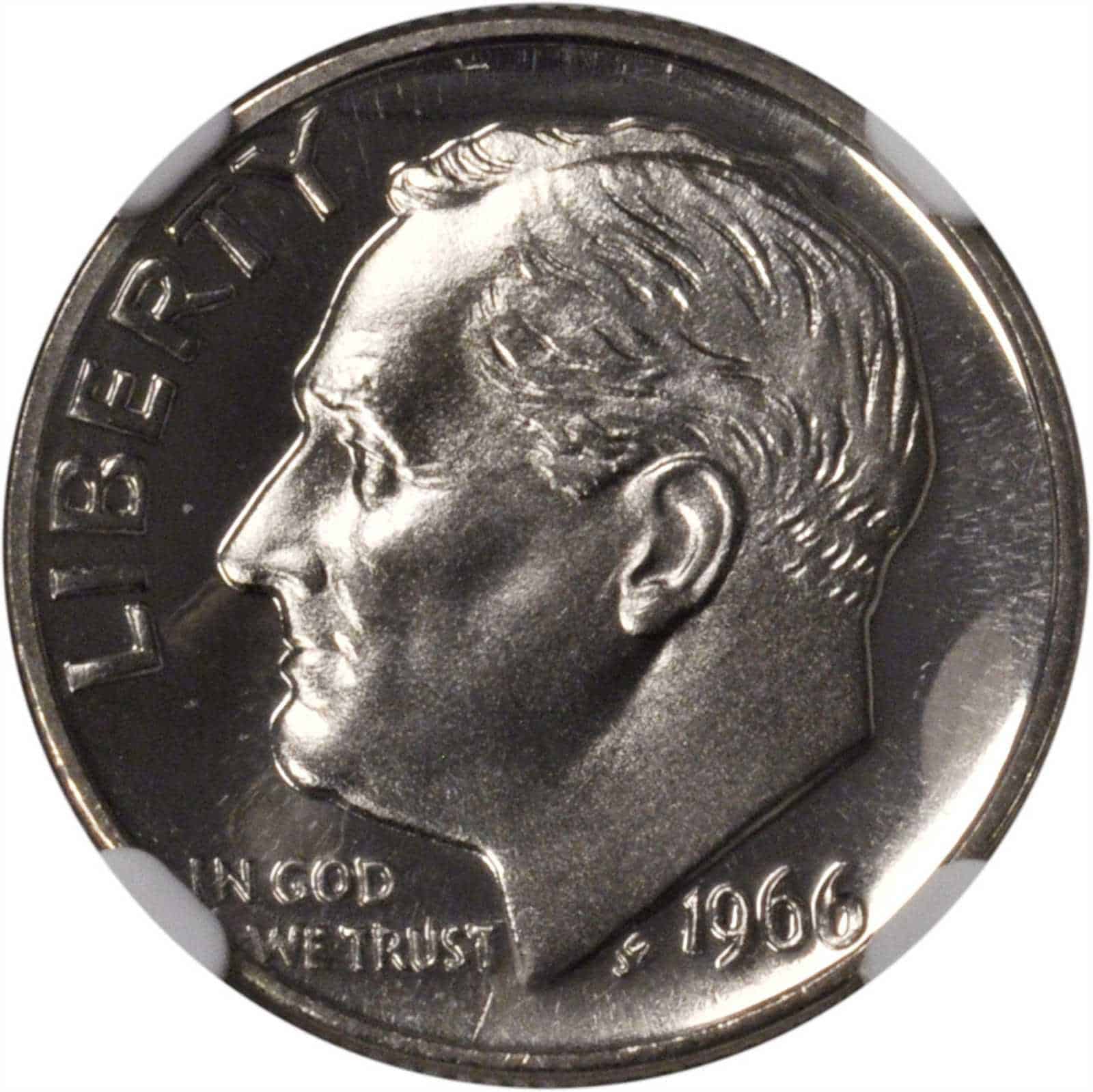
- Type – Roosevelt dime
- Edge – reeded
- Mint mark – no mint mark
- Place of minting – Philadelphia, Denver, and San Francisco
- Year of minting – 1966
- Face value – 10 cents
- Price – $0.10 – $500 +
- Quantity produced – around 1 400 000
- Designer – John Sinnock
- Composition – copper (91.67%) and nickel (8.33%)
- Mass – 2.26 grams (0.07 ounces)
- Diameter – 17.91 millimeters (0.7 inches)
A typical Roosevelt dime from 1966 has 118 reeds on the edges. Its face value is 10 cents which is the usual starting price for this coin nowadays. There were almost half a billion dimes minted during this year, so they are far from rare.
While the coins in poor condition sell for only several cents to several dollars, the ones that are in near-perfect condition can reach the price of $500 or even more.
If you have a 1966 dime that you want to sell, you should make sure that it doesn’t have any errors or other features that make it unique. You could sell a coin worth thousands for only a few dollars!
The same goes for buying a 1966 dime. Avoid shady online sellers that don’t have any reviews if you are looking to spend a lot of money on a coin. Buy from someone legitimate instead, preferably in person.
Keep in mind that these are just the estimated prices based on the previous 1966 dimes sold on auctions, online, and in person. The exact price depends on various factors, but the most important ones are the rarity of the coin and the buyer’s interest.
Also Read: Top 15 Most Valuable Roosevelt Dimes Worth Money
1966 Dime History
Dimes have a long history in the US. The first dimes were produced in 1796 and they were made entirely of silver. Up until 1837, the dimes featured Lady Liberty on the front and an eagle on the back of the coin.
In 1837, the eagle was replaced by a wreath of flowers on the reverse. In 1916 the reverse design was once again changed to fasces and an olive branch, the former representing the country’s military strength and the latter symbolizing peace.
The Lady Liberty was featured on the obverse of the coin until 1946, although the exact designs changed several times.
The Roosevelt dime saw the light of day in 1946, a year after the ex-president’s death. The US Mint released the coin on January 30th, the day of his birthday.
A dime wasn’t an arbitrary denomination choice for honoring Franklin Roosevelt. Since he founded the organization March for Dimes intending to cure polio, the US Mint decided that it was best to use his portrait for a dime, rather than for some other coin.
The Roosevelt dime is still used nowadays. The Philadelphia mint and the Denver mint produce uncirculated and circulated coins, while the San Francisco facility makes proof coins.
1966 Dime Appearance
The 1966 dime is silver in appearance. It features the left-facing portrait of Franklin Roosevelt on the center of the obverse of the coin.
To the portrait’s left side is the word LIBERTY which replaced the Lady Liberty featured in the designs before this one. Below this word is the US motto – IN GOD WE TRUST. To the right side of the ex-president’s portrait is the year, 1966.
The reverse of the coin features a torch at the center which is another symbol of liberty. To the left side of the torch is an olive branch, which symbolizes peace, and to the right side is an oak tree, which signifies strength.
In between the torch, an olive branch, and an oak tree is another motto of the US – ET PLURIBUS UNUM. On top of the coins are the words UNITED STATES OF AMERICA and at the bottom the words ONE DIME.
John Sinnock Controversies
There are some controversies regarding the designer of the US dime, John Sinnock. If you look closely at the front side of a 1966 dime, you will see his initials, JS. They are right between the portrait and the year.
There were rumors that John Sinnock actually honored Joseph Stalin and communism this way. While there is no evidence that this is in any way true, the rumors lingered for quite a long time.
Another controversy surrounding John Sinnock’s dime design relates to the sculptor by the name Selma Burke. Rumors were going around that Sinnock stole her design of Roosevelt’s portrait. However, this rumor was never proven either.
Also Read: Top 15 Most Valuable Indian Head Penny Worth Money
1966 Dime Grading
If you want to sell your 1966 dime, it’s best that you have it professionally graded first, especially if you are not an experienced numismatist.
Some coins hide unique features that you may not be able to notice but a grading service would. Some of these features can increase the price of your coin by hundreds of dollars, so don’t risk it – find out the exact grade of your coin before putting it on the market.
Your dime will get a grade from 1 to 70, and the higher the grade the more valuable your coin is.
Lists of 1966 Dime Errors
Another thing that a professional can notice but you may not are some potential errors on your 1966 dime. While some of them are obvious, some can be easily overlooked, so make sure to thoroughly inspect your coin so you don’t miss anything.
The US mint tries to eliminate factory errors from coins and avoids putting coins with mistakes into circulation. However, some errored coins go into the market anyway, and collectors love them!
The errors make the coins rare, which is why they increase the coins’ price even if they are not in perfect condition. Let’s see what some 1966 dime errors are.
1. 1966 Dime Clipped Planchet
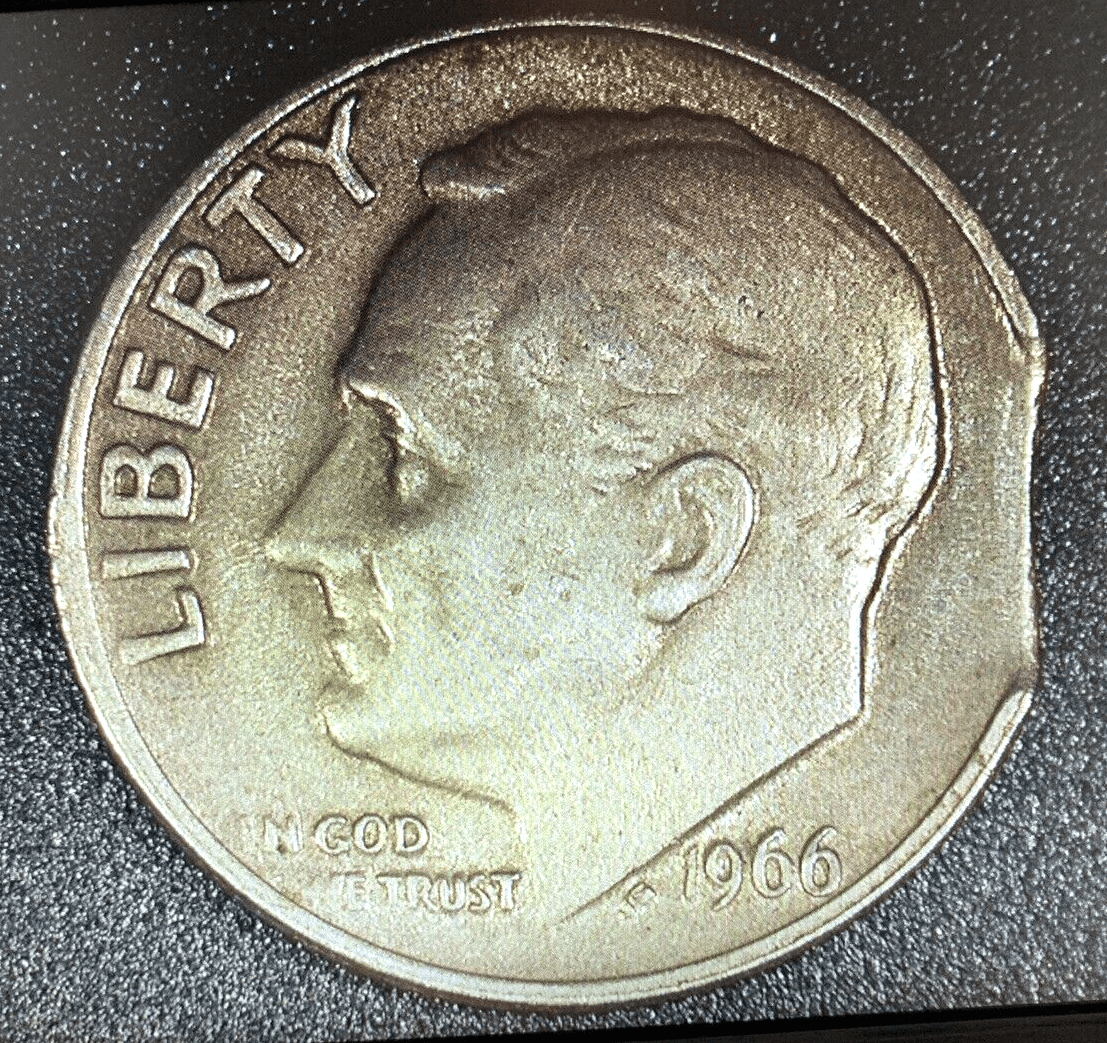
A planchet is a metal round disc that is used to make coins. The words and the design of the coin are engraved on a planchet during the minting process.
One of the errors that make the collectors interested in buying a coin is the clipped planchet. It is easily noticeable – if a part of your coin is missing, your coin contains this error.
2. 1966 Dime Missing Letters
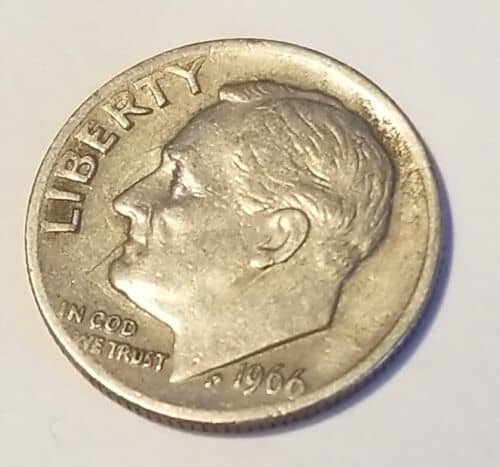
Some of the dimes from 1966 have one or more letters missing from the words “liberty” and from the motto “in God we trust”.
This error is quite unique, so if you have one or more coins with this mistake, you are lucky!
Keep in mind that someone may try to falsify this error, so be careful when buying coins online or from unverified users.
3. 1966 Dime Off-Center Error
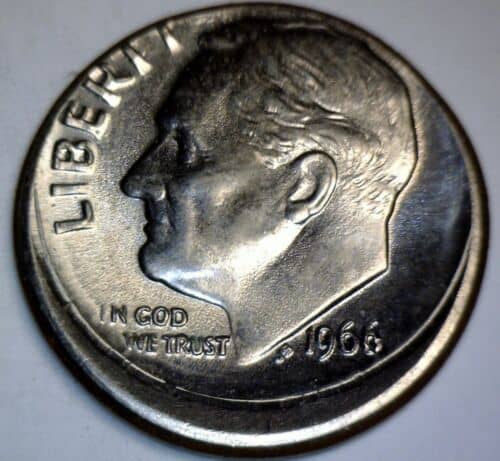
Your coin’s design may appear weird or misplaced. This can be due to the off-center error, when a planchet is not correctly positioned between the dies during the minting process. This results in a design that is not correctly placed on the coin, making it more valuable.
4. 1966 Dime Double Die
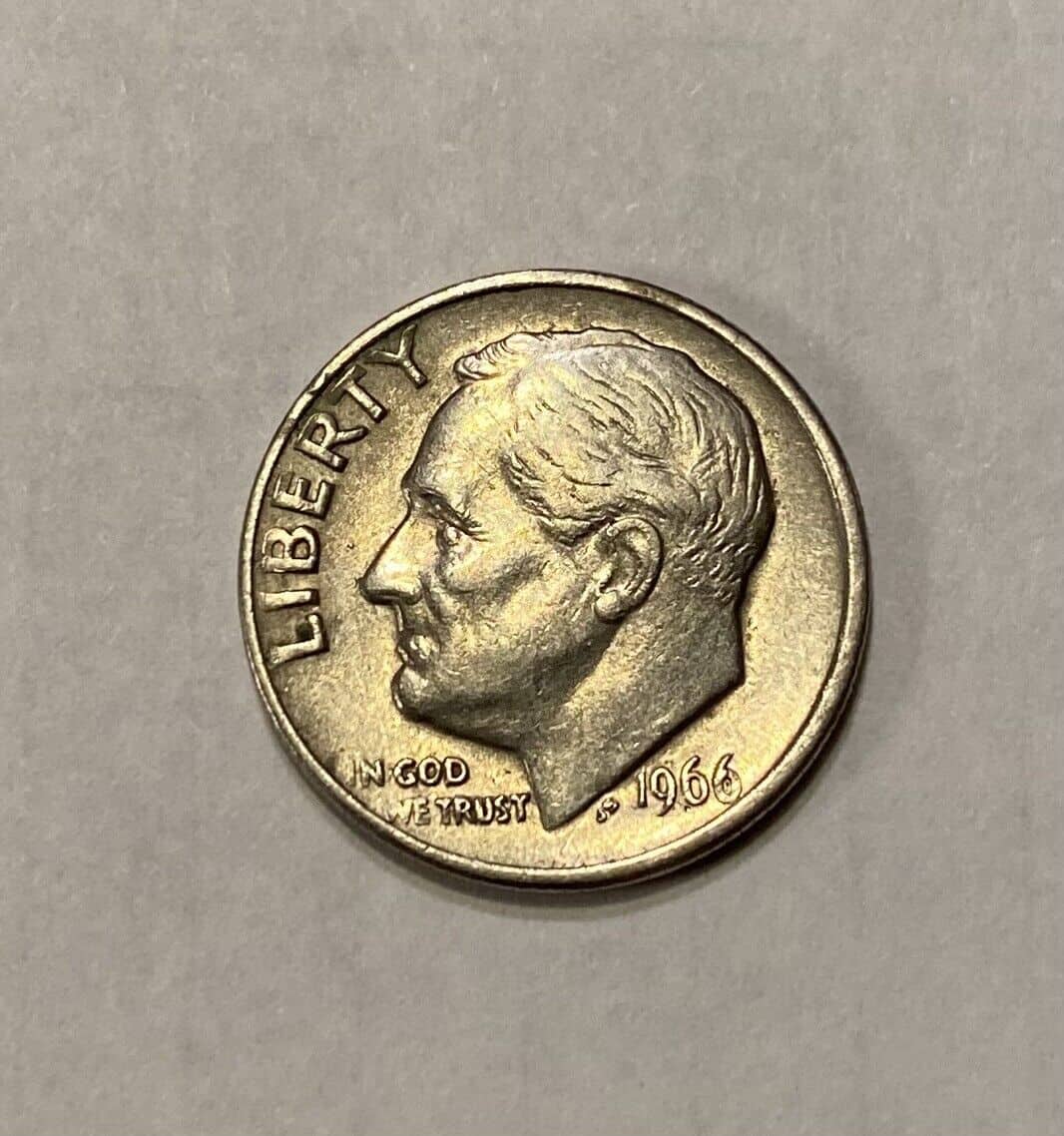
The double die error happens when the dies that engrave the design on a planchet strike twice. This error can be difficult to notice if you don’t observe it carefully, so always check multiple times before selling your coin. It may be worth much more than you initially expect!
5. 1966 Dime Die Crack
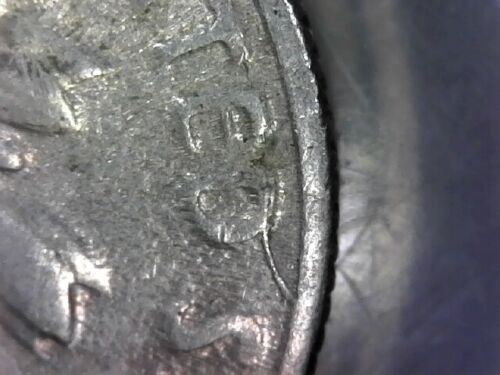
A die crack happens when the dies used to engrave a planchet is worn off or damaged. This results in a break in the design of a coin.
Sometimes the error is obvious but sometimes it will be more difficult to notice it. Use a magnifying glass to inspect your coin closely.
This error can increase the value of a 1966 dime by several dollars if average condition. While it is not a lot, it is still worth checking.
Naturally, your coin will be worth much more if it is graded 65+ apart from having a factory error.
1966 Dime FAQ
Is a dime from 1966 worth anything?
Yes! A dime from 1966 is worth at least its face value, which is 10 cents. The dimes in better condition can reach prices of hundreds of dollars. Those that have a unique error on top of the great condition can be sold for more than a thousand dollars.
Is a 1966 dime rare?
No, a dime from 1966 is not that rare. The US Mint produced almost a billion and a half of these coins so there are plenty on the market. However, dimes from 1966 that have a grade above 68 are relatively rare and therefore much more expensive than those in poor condition.
Is a 1966 dime silver?
No, a dime from 1966 is made of copper and nickel. In fact, this was the first year when the dimes were not made of silver due to the metal’s rising prices back then.

